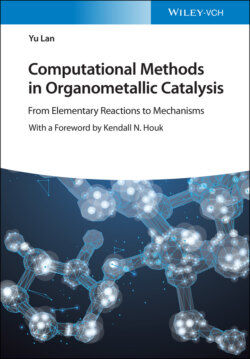Читать книгу Computational Methods in Organometallic Catalysis - Yu Lan - Страница 18
1.2.2 Mechanistic Study of Transition Metal Catalysis by Theoretical Methods
ОглавлениеQuantum chemical computation based on first principle provides a powerful tool for the mechanistic study of transition metal catalysis. Since the whole content of this book is to discuss the theoretical calculation‐based study for the mechanism of transition metal catalysis, we will give only a few examples to show how to study the reaction mechanism by theoretical calculations.
Generally, mechanism research of transition metal catalysis initially faces a series of studies involving the molecular structure and electronic states. As an example, (Xantphos)Pd(CH2NBn2)+ is an important precursor for aminomethylation reactions, the geometric structure of which has been confirmed by X‐ray analysis [87]. However, why this complex could be formed and the electronic properties of this complex still remained unclear. As shown in Scheme 1.5, in resonance structure 1‐1, the Pd—C bond is a normal single bond, and Pd—N is a coordination bond. The formal positive charge is localized on palladium, and the formal oxidation state of palladium is +2. Alternatively, the iminium moiety acts as a monodentate ligand coordinated with Pd(0) in resonance structure 1‐2, and the formal positive charge is mainly localized on the iminium moiety. The real structure of this complex would be a mixture of resonance structures 1‐1 and 1‐2. On the other hand, the bond orders of Pd—C, Pd—N, and C—N are determined to be 0.322, 0.135, and 0.965, respectively, which indicate that the Pd—C and Pd—N bonds are very weak. More importantly, these data support that the C—N is a double bond and 1‐2 is most likely to be the main structure of this complex. Further frontier molecular orbital studies also supported this point.
Scheme 1.5 The resonance structures of (Xantphos)Pd(CH2NBn2)+.
To summarize, computational organometallic chemistry focuses on some of the stationary points on potential energy surface for the corresponding reactions, which could be used to compare the possible elementary reactions. The lowest energy reaction pathway could be found by theoretical calculations, which is helpful for chemists to understand the reaction mechanism and design new reactions.
As an example, computational method was used to study the mechanism of rhodium‐catalyzed coupling reaction of quinoline N‐oxide and acetylenes. As shown in Scheme 1.6, four possible pathways were taken into account (i.e. paths A–D) [88]. All these four pathways begin with the coordination of quinoline N‐oxide to Rh(III) precursor 1‐6, which is followed by an N‐oxide‐directed electrophilic deprotonation by acetate and coordination of acetylene substrate to give rhodacycle 1‐7. The subsequent insertion of the acetylene substrate into the Rh—C bond of intermediate 1‐7 gives intermediate 1‐8, which is a common intermediate for both paths A and C. In path A, complex 1‐8 is proposed to undergo a reductive elimination reaction to form a new C—O bond in π‐coordinated complex 1‐9. The N—O bond in complex 1‐9 would then oxidatively add back to Rh(I) to generate Rh(III) enolate intermediate 1‐10. Protonolysis of intermediate 1‐10 by acetic acid would release one molecule of product 1‐5 and regenerate complex 1‐6. Product 1‐5 could also be generated by the protonation of intermediate 1‐14, which is an isomer of intermediate 1‐10. In path C, the migration of the oxygen atom from complex 1‐8 would lead to the formation of Rh(V)–oxo intermediate 1‐11. A subsequent oxygen insertion into Rh—C(vinyl) bond may give rise to intermediate 1‐10, which is the common intermediate in path A. Alternatively, the insertion of the acetylene substrate into the Rh—O bond of intermediate 1‐7 would give rise to a common intermediate 1‐12, which could proceed along path B or path D. For path B, cleavage of the N—O bond would lead to the formation of α‐oxo carbenoid species 1‐13, which could undergo carbene insertion to give intermediate 1‐14. This intermediate is either protonated directly or isomerizes to intermediate 1‐10, followed by protonolysis to afford product 1‐5 together with the regeneration of active catalyst 1‐6. Intermediate 1‐12 could also undergo reductive elimination through path D to give complex 1‐10. All four of these different pathways have been evaluated in the current study by using theoretical calculations. The computational results revealed that path A is the most favorable process for this reaction.
Scheme 1.6 Mechanism of rhodium‐catalyzed coupling reaction of quinoline N‐oxide and acetylenes.
Source: From Li et al. [88].
In fact, quantum chemical calculations have become one of the conventional methods to study the mechanism of transition metal catalysis (Scheme 1.7). The basis function of computational organometallic chemistry is to calculate the geometries and energies of stationary points, including local minimums and transition states, so as to construct potential energy surface for the catalytic cycle and explore the reaction mechanism. Information of molecular orbital, charge distribution, dipole moment, and so on can be achieved by computational population analysis, which is propitious to study factors of reactivity and selectivity. More useful information, including infrared, nuclear magnetic resonance, circular dichroism spectra, dispersion interactions, nucleophilicity/electrophilicity, and aromaticity, also can be achieved by theoretical calculations for organometallic chemistry.
Scheme 1.7 Mechanism study of organometallic catalysis by density functional theory (DFT) calculations.
Over recent several decades, massive experimental and theoretical investigations were reported about organometallic catalysis. In those works, theoretical studies have proved to be indispensable routine technique for modern synthetic organic chemistry. Consequently, we herein provide a book to summarize and generalize the theoretical advances regarding organometallic catalysis. In Chapter 2, we summarize the popular computational methods, which are of benefit for the mechanism study of organometallic catalysis. We discuss the theoretical studies of elementary reactions in Chapter 3. Detailed processes for all the familiar elementary reactions in organometallic catalysis discovered by theoretical calculations are summarized in this chapter. Based on those two chapters, the second part of this book is organized by the type of transition metals, which are used as catalyst in organic reactions.
